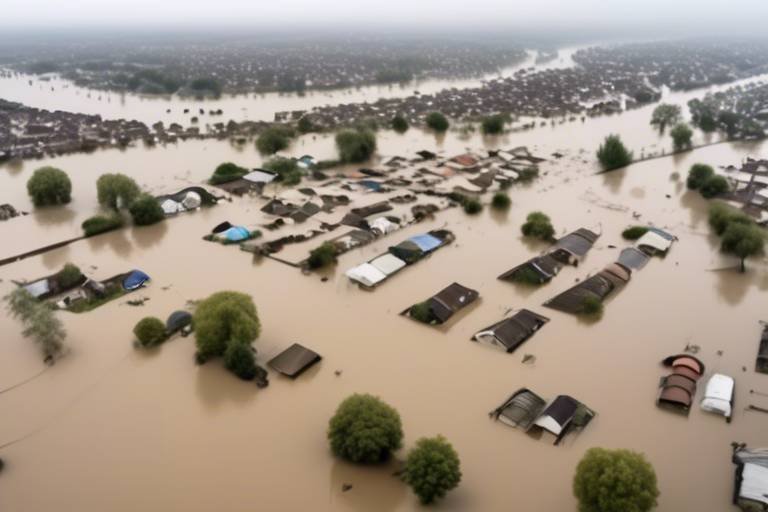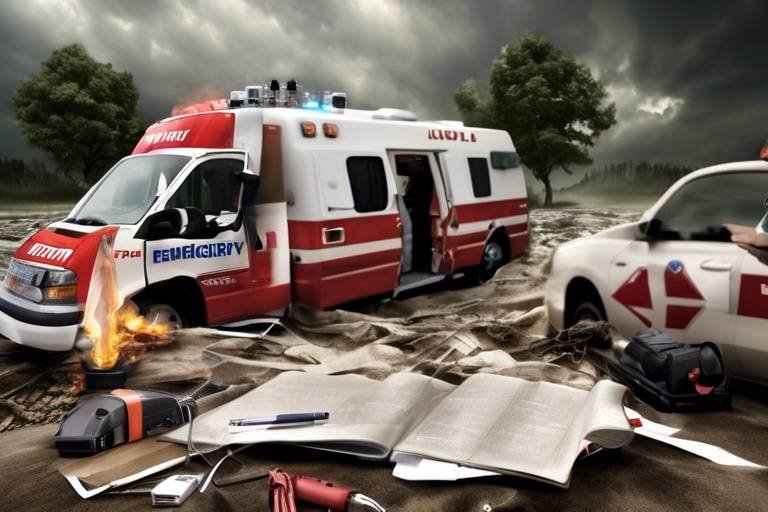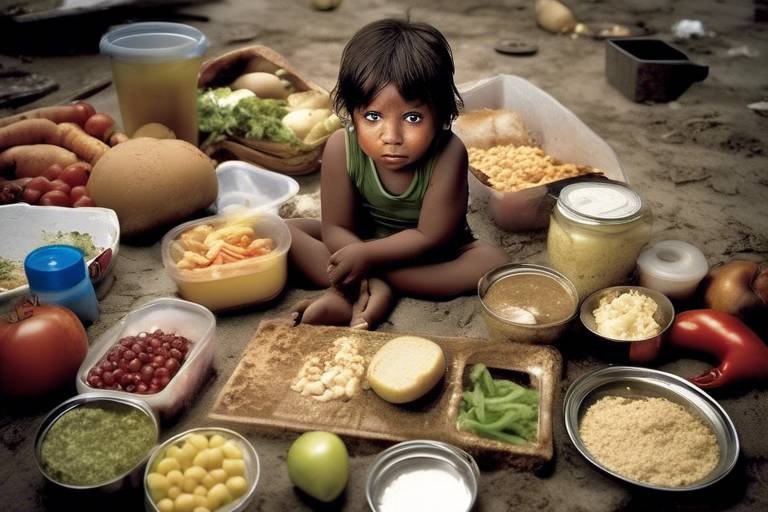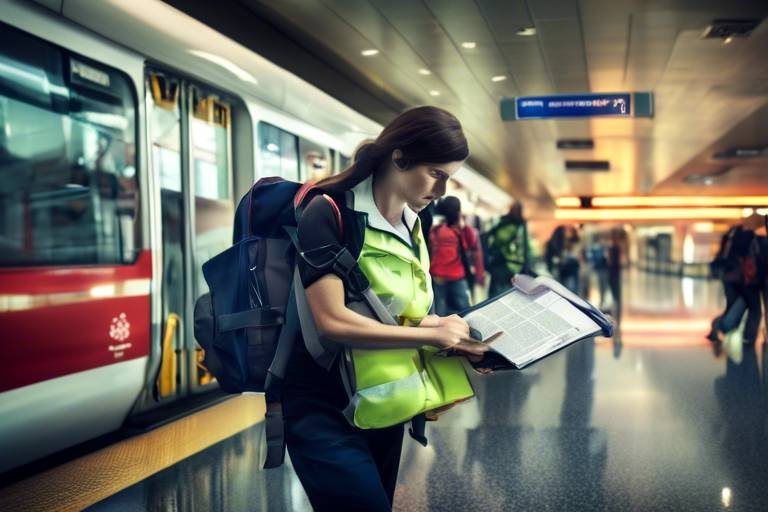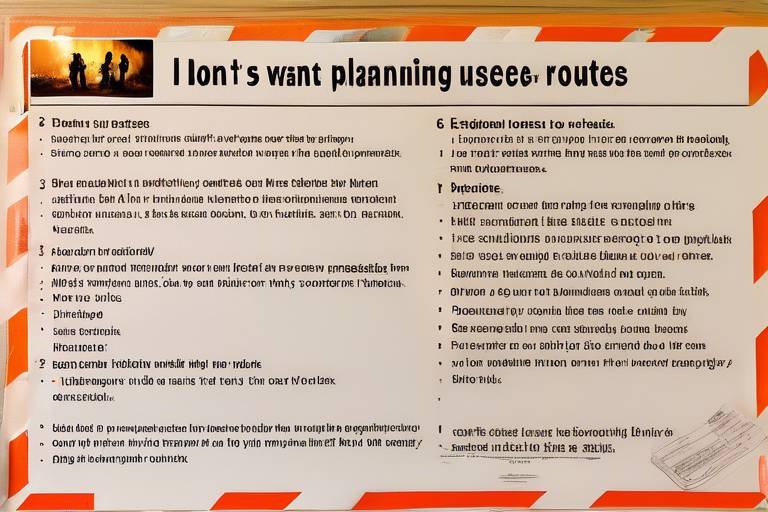How to Deal with a Blackout? Essential Tips
Blackouts can strike unexpectedly, leaving you in the dark—literally and figuratively. Imagine sitting in your living room, enjoying a cozy evening, when suddenly the lights flicker and go out. It's a disorienting experience that can cause panic, especially if you're unprepared. The good news is that with the right strategies, you can navigate through a blackout with ease and confidence. This article provides practical strategies and essential tips to effectively manage a blackout, ensuring safety and comfort during unexpected power outages.
Before diving into how to manage a blackout, it's important to understand what causes them. Blackouts can occur due to a variety of reasons, such as severe weather, equipment failure, or even high demand on the power grid. They can happen at any time, and their frequency can vary depending on your location. Understanding the nature of blackouts helps you prepare and respond appropriately when they occur. For instance, if you live in an area prone to storms, you might experience more frequent outages. Knowing this can motivate you to stock up on essential supplies and create a solid plan.
Preparation is key to minimizing the impact of a blackout. Think of it as setting up a safety net—when you have the right tools and knowledge, you can bounce back quickly. Here are some essential items to stock up on and steps to take before an outage strikes:
Identifying critical emergency supplies to have on hand can make a significant difference during a blackout. Consider keeping the following items readily available:
- Flashlights: Ensure you have a reliable flashlight for each member of your family.
- Batteries: Stock up on batteries of various sizes for your devices.
- Non-perishable food: Canned goods and dry snacks can sustain you during an outage.
Having these items ready not only provides comfort but also ensures you can manage basic needs without electricity.
In the chaos of a blackout, minor injuries can happen. Therefore, it's crucial to have a well-stocked first aid kit. This kit should include bandages, antiseptics, and any necessary medications. Knowing how to treat minor injuries during a blackout can be crucial when medical help is not immediately available. Think of it as your own personal safety net that you can rely on when the unexpected happens.
Investing in battery-powered devices like radios and chargers can keep you informed and connected during an outage. These tools provide essential updates and communication, allowing you to stay in the loop with news and developments. Imagine being able to listen to emergency broadcasts or charge your phone to contact loved ones—these small devices can make a world of difference.
Developing a blackout plan for your household is essential. This plan should outline communication strategies, safety protocols, and designated meeting points for family members. Think of it as your family’s game plan; when everyone knows what to do, it reduces confusion and anxiety. Discuss the plan with your family members, ensuring everyone understands their roles and responsibilities during a blackout.
Safety should be your top priority during a blackout. It’s easy to overlook safety in the midst of chaos, but following a few important tips can help avoid accidents and ensure everyone’s well-being. For instance, while candles can provide light, it's essential to use them safely. Understand the risks and best practices for using candles to prevent fires during a blackout. Always place them on stable surfaces away from flammable materials, and never leave them unattended.
Food safety is another critical aspect during a blackout. Understanding refrigeration times and safe food storage can help prevent food spoilage and waste. Typically, a refrigerator will keep food safe for about 4 hours if the door remains closed. For longer outages, consider using coolers with ice packs to keep perishables safe. It’s like playing a game of Tetris—strategically placing items to maximize space and maintain freshness can save you from throwing out spoiled food later.
Once power is restored, it's important to assess the situation. Discover steps to take immediately after a blackout to ensure your home and family are safe. First, check your appliances for any potential damage. Knowing how to safely restart them can prevent further issues and ensure they function properly. If you notice any unusual smells or sounds, it’s best to unplug them and consult a professional.
After a blackout, evaluate your emergency supplies. Restocking essential items ensures you're better prepared for any future outages, enhancing your overall preparedness strategy. Just like you wouldn’t let your car run low on gas, don’t let your emergency supplies dwindle. Make it a habit to check and replenish your stock regularly, so you’re always ready for whatever comes your way.
Q: What should I do if a blackout lasts for an extended period?
A: Stay calm and keep your refrigerator and freezer closed as much as possible. Use coolers with ice if needed, and prioritize using non-perishable food items.
Q: How can I stay informed during a blackout?
A: Battery-powered radios are a great way to receive news updates. Additionally, ensure your mobile devices are charged beforehand, and consider using a portable charger.
Q: Are there any safety tips for using generators during a blackout?
A: Absolutely! Always use generators outdoors to prevent carbon monoxide buildup, and keep them away from windows and doors. Follow the manufacturer's instructions for safe operation.

Understanding Blackouts
This article provides practical strategies and essential tips to effectively manage a blackout, ensuring safety and comfort during unexpected power outages.
Blackouts can be unexpected and often leave us feeling vulnerable, as if we’ve been plunged into darkness without a lifeline. But what exactly causes these power outages? In many cases, blackouts occur due to a variety of factors, including severe weather conditions, equipment failures, or even human error. For instance, a sudden storm can knock out power lines, while an overloaded electrical grid can lead to cascading failures. Understanding these causes is crucial for effective preparation.
Did you know that blackouts are more common than you might think? According to the U.S. Energy Information Administration, the average American experiences about 1.3 outages per year, lasting anywhere from a few minutes to several hours. This frequency can vary based on your location, with some areas experiencing outages more often due to aging infrastructure or frequent storms.
The impact of a blackout can be felt in various aspects of daily life. Imagine trying to cook dinner in complete darkness or missing out on important communications because your devices are dead. During a blackout, you might face challenges such as:
- Loss of refrigeration - Food can spoil quickly without power.
- Communication breakdown - Without charged devices, staying informed becomes difficult.
- Safety hazards - Navigating in the dark can lead to accidents.
By understanding the nature of blackouts, you can better prepare yourself and your family. Knowledge is power, and being informed about the potential causes and effects of a blackout equips you to respond appropriately. So, the next time the lights flicker, don’t panic—remember that you have the tools and strategies to manage the situation effectively.
Preparation is key to minimizing the impact of a blackout. Discover essential items to stock up on and steps to take before an outage strikes.
Identify critical emergency supplies to have on hand, such as flashlights, batteries, and non-perishable food. Having these items ready can make a significant difference during a blackout.
Ensure you have a well-stocked first aid kit. Knowing how to treat minor injuries during a blackout can be crucial when medical help is not immediately available.
Invest in battery-powered devices like radios and chargers. These tools can keep you informed and connected during an outage, providing essential updates and communication.
Developing a blackout plan for your household is essential. This plan should outline communication strategies, safety protocols, and designated meeting points for family members.
Safety should be your top priority during a blackout. Learn important safety tips to follow to avoid accidents and ensure everyone's well-being.
While candles can provide light, it's essential to use them safely. Understand the risks and best practices for using candles to prevent fires during a blackout.
Learn how to manage food safety during a blackout. Understanding refrigeration times and safe food storage can help prevent food spoilage and waste.
Once power is restored, it's important to assess the situation. Discover steps to take immediately after a blackout to ensure your home and family are safe.
After a blackout, check your appliances for any potential damage. Knowing how to safely restart them can prevent further issues and ensure they function properly.
Evaluate your emergency supplies post-blackout. Restocking essential items ensures you're better prepared for any future outages, enhancing your overall preparedness strategy.
Q: What should I do during a blackout?
A: Stay calm, use flashlights instead of candles if possible, and avoid opening the refrigerator to keep food cold.
Q: How long can food last without power?
A: Generally, a full refrigerator can keep food safe for about 4 hours, while a full freezer can last for about 48 hours if unopened.
Q: How can I prepare for future blackouts?
A: Stock up on emergency supplies, create a blackout plan, and stay informed about weather conditions that could lead to outages.

Preparation Before a Blackout
When it comes to blackouts, being prepared can make all the difference between chaos and calm. Imagine the lights suddenly flickering out, leaving you in darkness. It’s a scenario that can happen to anyone, whether due to severe weather, technical failures, or even unexpected demand on the power grid. To ensure that you and your loved ones stay safe and comfortable during these uncertain times, it’s crucial to have a solid plan in place. Preparation is not just about having a few flashlights lying around; it’s about creating a comprehensive strategy that covers all bases.
First and foremost, stocking up on emergency supplies is essential. Think of it as your personal safety net. You wouldn’t go skydiving without a parachute, right? Similarly, you shouldn’t face a blackout without the necessary tools and supplies. Here’s a quick rundown of some critical items you should have on hand:
- Flashlights - A reliable source of light is non-negotiable. Opt for LED flashlights as they last longer and are energy-efficient.
- Batteries - Keep an assortment of batteries to power your flashlights, radios, and other essential devices.
- Non-perishable food - Stock up on canned goods, dry snacks, and bottled water. These items can sustain you and your family when cooking becomes a challenge.
- First aid kit - Accidents can happen, and knowing you have the supplies to handle minor injuries can provide peace of mind.
Speaking of first aid kits, let’s dive a little deeper into that aspect. Having a well-stocked first aid kit is more than just a box of band-aids. It should include items like antiseptic wipes, gauze, pain relievers, and any necessary prescription medications. In a blackout, medical help may not be readily available, so being equipped to handle minor injuries is not just smart; it’s vital.
Next, consider investing in battery-powered devices. A battery-powered radio can be a lifesaver during a blackout. It keeps you informed about weather updates and emergency alerts, allowing you to stay connected to the outside world. Additionally, having portable chargers for your devices ensures that you can communicate with others if the power is out for an extended period. Think of these devices as your lifelines, connecting you to vital information and people.
Finally, it’s essential to create a blackout plan tailored to your household. This plan should outline how you’ll communicate with each other during an outage, safety protocols to follow, and designated meeting points in case family members are separated. Just like a fire drill, having a plan in place can reduce panic and confusion when the lights go out. Take the time to discuss this plan with everyone in your home, ensuring that everyone knows what to do and where to go.
In summary, preparation is your best defense against the unpredictability of blackouts. By gathering essential supplies, investing in the right devices, and creating a solid plan, you can transform a potentially stressful situation into a manageable one. Remember, being prepared doesn’t just mean having the right stuff; it means having the right mindset. So, take the time to prepare now, and you’ll thank yourself later when the lights go out.
Q: How long can food last in the refrigerator during a blackout?
A: Generally, food in the refrigerator can last about 4 hours without power. If the door remains closed, the freezer can keep food safe for up to 48 hours.
Q: What should I do if I have medical devices that require power?
A: If you rely on medical devices, consult with your healthcare provider and have a backup power source, like a generator, ready to go.
Q: Are there any safety tips for using candles during a blackout?
A: Yes! Always place candles on stable surfaces, away from flammable materials, and never leave them unattended. Consider using battery-operated candles as a safer alternative.

Emergency Supplies
When it comes to preparing for a blackout, having the right on hand can make all the difference. Imagine you're sitting in your living room, the lights flicker, and suddenly, darkness envelops your home. Panic can easily set in, but if you’ve stocked up on essential items, you’ll feel more like a seasoned pro than a deer caught in headlights. So, what should you have ready before the lights go out? Let's dive into the must-haves!
First and foremost, you’ll want to ensure you have a reliable source of light. Flashlights are your best friends during a blackout. They’re portable, easy to use, and much safer than candles. But don’t forget to stock up on batteries as well! There’s nothing worse than reaching for your flashlight only to find it dead. Consider keeping a few extra batteries in various sizes, so you’re never caught off guard.
In addition to lighting, think about your food and water needs. Having a supply of non-perishable food is crucial. Items like canned goods, dried fruits, and granola bars can keep you nourished without refrigeration. Make sure to also have enough bottled water to last for at least three days—about one gallon per person per day is a good rule of thumb. This way, you can stay hydrated and keep your energy up while waiting for the power to return.
Another essential item is a battery-powered radio. This little device can be a lifesaver, allowing you to stay updated on weather conditions and emergency announcements. If you have a smartphone, consider investing in a portable charger to keep it powered up as well. Being able to communicate with the outside world during a blackout can provide peace of mind and help you coordinate with family and friends.
To wrap things up, here’s a quick overview of the emergency supplies you should consider having:
| Item | Purpose |
|---|---|
| Flashlights | Provide light during the blackout |
| Batteries | Power your flashlights and other devices |
| Non-perishable food | Keep you nourished without refrigeration |
| Bottled water | Ensure hydration |
| Battery-powered radio | Stay informed about updates |
| Portable charger | Keep your devices charged |
By taking the time to gather these supplies in advance, you can transform a potentially stressful situation into a manageable one. Remember, preparation is the name of the game!

First Aid Kits
When the lights go out, the last thing you want is to be caught off guard, especially when it comes to health and safety. Having a well-stocked first aid kit is not just a good idea; it's a necessity during a blackout. Imagine a scenario where someone in your home gets a minor injury, and the nearest medical help is hours away due to the power outage. This is where your first aid kit becomes your best friend. It’s like having a superhero in your corner, ready to swoop in and save the day!
Your first aid kit should include a variety of essential items to handle common injuries and emergencies. At a minimum, consider stocking it with:
- Adhesive bandages in various sizes
- Antiseptic wipes or solutions
- Gauze pads and medical tape
- Scissors and tweezers
- Disposable gloves
- Pain relievers like ibuprofen or acetaminophen
- Any personal medications that family members may need
But don’t just toss these items into any old box! Organize your kit so that you can quickly find what you need during an emergency. You might want to use a waterproof container to protect your supplies from potential water damage, especially if you live in an area prone to flooding or heavy rains. Think of your first aid kit as your own personal medical command center, where every item has its place and is ready for action!
Additionally, it's wise to regularly check the contents of your first aid kit. Medicines can expire, and bandages can lose their adhesive quality over time. Make it a habit to review your kit every six months or so, perhaps during the changing of the seasons. This way, you can ensure that everything is fresh and ready to go when you need it most. Your family’s safety is paramount, and being prepared can make all the difference in an emergency situation.
In conclusion, a first aid kit is an indispensable part of your blackout preparation. It’s not just about having the supplies; it’s about knowing how to use them effectively. Consider taking a basic first aid course if you haven’t already. This knowledge, coupled with a well-stocked kit, equips you to handle minor injuries and keep your loved ones safe during those unexpected moments when the lights go out.
Here are some common questions regarding first aid kits during a blackout:
- What should I include in my first aid kit? Essential items include bandages, antiseptic wipes, gauze, scissors, and personal medications.
- How often should I check my first aid kit? It's recommended to check your kit every six months to ensure all items are in good condition and not expired.
- Can I use my first aid kit for pets? Yes, consider adding pet-specific items like bandages and antiseptics if you have pets at home.

Battery-Powered Devices
When the lights go out, one of the most important things you can do is stay connected and informed. This is where come into play. Imagine sitting in the dark, not knowing what's happening outside your home, or when the power will return. It's a bit like being on an island cut off from the rest of the world! Having the right battery-powered devices can turn that isolation into a manageable situation.
First and foremost, a battery-powered radio is an essential tool during a blackout. It allows you to tune into local news stations for updates on the outage, weather alerts, and safety information. Think of it as your lifeline to the outside world. Make sure to have a good supply of batteries ready, so you’re not left in silence. You can also consider radios that come with solar charging capabilities or hand-crank options, which can be lifesavers when your batteries run low.
Another key device is a battery-powered charger for your mobile devices. In today's world, our smartphones are not just communication tools; they are our connection to the internet, social media, and emergency contacts. Imagine needing to call for help or check on loved ones but finding your phone dead! Investing in a portable charger or a power bank ensures that you can keep your devices powered up, even when the electricity is out.
In addition to radios and chargers, consider having LED lanterns or flashlights on hand. Unlike traditional candles, which can pose a fire hazard, these devices provide a safe and reliable source of light. They come in various sizes and brightness levels, so you can choose one that suits your needs. Plus, many LED lights are energy-efficient and can last for hours on a single set of batteries, making them a great choice for long-lasting illumination.
Lastly, don’t overlook the importance of a battery-powered fan. If you live in a warm climate, a fan can help circulate air and keep you cool during a blackout, which can be especially important in the summer months. Look for models that can run on batteries and provide multiple speed settings for maximum comfort.
To summarize, having a selection of battery-powered devices can significantly enhance your comfort and safety during a blackout. Here’s a quick overview of the key devices you should consider:
| Device | Purpose | Additional Features |
|---|---|---|
| Battery-Powered Radio | Stay informed about the outage and receive emergency updates | Solar charging or hand-crank options |
| Battery-Powered Charger | Keep your mobile devices charged | Portable and lightweight |
| LED Lanterns/Flashlights | Provide light safely | Energy-efficient, long-lasting |
| Battery-Powered Fan | Keep cool during hot weather | Multiple speed settings |
In conclusion, being prepared with the right battery-powered devices can transform a stressful blackout experience into a manageable one. So, take a moment to gather these supplies now, and you'll be grateful when the unexpected happens!

Creating a Blackout Plan
When it comes to handling a blackout, having a solid plan in place can be a game changer. Think of it as your family's playbook for navigating the unexpected darkness that can sometimes envelop your home. Start by gathering your family members for a discussion about what to do in case the lights go out. It’s not just about knowing where the flashlights are; it’s about establishing a clear line of communication and a strategy for safety. Ask yourself, “What would we do if the power went out right now?” This simple question can lead to a comprehensive plan that keeps everyone calm and collected.
Your blackout plan should cover several critical aspects. First, designate a meeting point where all family members can gather if you get separated. This could be the living room, a neighbor's house, or even outside, depending on your home's layout. Next, establish a communication strategy. In today's world, we often rely on our smartphones, but during a blackout, cell service can be spotty. Consider investing in a battery-powered radio to stay updated on emergency information. You could also use walkie-talkies if your family is large or if you have older kids who might wander off.
Additionally, think about how you’ll handle various situations during a blackout. For instance, if someone in your household takes medication that needs refrigeration, have a backup plan for keeping it cool. This could involve using ice packs in a cooler or knowing how long your refrigerator will keep things cold. Also, discuss ways to keep entertained without electricity. Board games, books, and even storytelling can keep spirits high and provide a sense of normalcy.
To help you visualize your blackout plan, consider creating a Blackout Plan Checklist. This checklist can serve as a handy reference during an outage. You might include items such as:
- Designated meeting point
- Emergency contact numbers
- Battery-powered devices available
- Food and water supplies
- First aid kit location
Don’t forget to practice your plan! Just like a fire drill, rehearsing your blackout plan can make all the difference when the lights actually go out. Gather the family and simulate a blackout scenario to see how well everyone knows their roles. This practice can help reduce panic and confusion during an actual event. Remember, a well-prepared family is a safe family, and having a blackout plan can turn a potentially stressful situation into a manageable one.

Staying Safe During a Blackout
When the lights go out, it can feel like the world has come to a standstill. But fear not! Staying safe during a blackout is all about being prepared and knowing what to do. First things first, your safety should always be the number one priority. It’s easy to panic when the unexpected happens, but a little forethought can go a long way in keeping you and your loved ones secure.
One of the most common ways people try to light up their surroundings during a blackout is by using candles. While they can create a warm, cozy atmosphere, they also pose significant risks. Did you know that candle-related fires account for thousands of home fires each year? To use candles wisely, here are some essential tips:
- Always place candles on a stable surface away from flammable materials.
- Never leave candles unattended, and make sure to extinguish them before you leave a room or go to sleep.
- Consider using battery-operated candles as a safer alternative.
Another critical aspect of staying safe during a blackout is managing food and refrigeration. If the power goes out, it’s important to know how long your food will stay safe. The general rule of thumb is that a full refrigerator will keep food safe for about 4 hours, while a full freezer can keep food frozen for 24 hours if unopened. Here’s a quick breakdown:
| Appliance | Time Food Remains Safe |
|---|---|
| Refrigerator | Up to 4 hours |
| Freezer (full) | Up to 24 hours |
| Freezer (half-full) | Up to 12 hours |
To minimize food spoilage, try to keep the refrigerator and freezer doors closed as much as possible. If you're unsure about the safety of your food after the blackout, it’s better to be safe than sorry. When in doubt, throw it out!
Lastly, it’s essential to stay informed during a blackout. Battery-powered devices like radios can be your lifeline to the outside world. They will keep you updated on the situation, including when the power is expected to be restored. If you have a smartphone, ensure you have a portable charger ready, so you can stay connected with family and friends. Remember, communication is key, especially during emergencies.
In conclusion, while blackouts can be unsettling, knowing how to stay safe can make all the difference. By using candles wisely, managing your food supplies, and staying informed, you can navigate through these challenging times with confidence.
- What should I do if the power goes out during a storm? It's best to stay indoors, avoid using candles if possible, and keep your refrigerator and freezer closed.
- How can I prepare for future blackouts? Stock up on emergency supplies like flashlights, batteries, and non-perishable food items.
- Is it safe to use a generator during a blackout? Yes, but ensure it’s placed outside and away from windows to avoid carbon monoxide poisoning.

Using Candles Wisely
When the lights go out and darkness envelops your home, candles can become your best friends, providing a warm glow that can ease the tension of a blackout. However, while they can create a cozy atmosphere, it’s crucial to use them wisely to avoid potential hazards. First and foremost, always place candles on stable, heat-resistant surfaces, away from anything flammable. Think of it like setting a stage for a performance; you want to ensure that the spotlight remains on the candle without any distractions or dangers lurking nearby.
Moreover, never leave candles unattended. It’s easy to get caught up in other tasks during an outage, but a moment of distraction could lead to a disaster. Imagine having a lovely candlelit dinner only to have it turn into a frantic dash to put out a fire! To mitigate risks, consider using candle holders that are specifically designed to catch wax drips and prevent tipping over. These holders act like a safety net, ensuring that your flickering flame doesn’t turn into a raging inferno.
Another tip is to trim the wick to about a quarter of an inch before lighting it. This simple act can help the candle burn more evenly and produce less soot, giving you a cleaner and brighter light. You wouldn’t want your lovely ambiance to be marred by an unsightly black mark on your walls or ceiling, would you? Additionally, it’s wise to keep candles out of reach of children and pets. Just like how you wouldn’t let a toddler play with fireworks, candles require the same level of caution.
Lastly, consider investing in LED candles as a safer alternative. These battery-operated beauties mimic the flicker of real flames without the fire risk. They can be a game-changer during a blackout, providing light without the need for constant supervision. So, the next time you find yourself in the dark, remember to use candles wisely and prioritize safety while still enjoying the comforting glow they provide.

Managing Food and Refrigeration
When the lights go out, one of the biggest concerns for many households is how to manage food and refrigeration. After all, no one wants to open their fridge only to find spoiled food staring back at them. So, what can you do to keep your food safe during a blackout? First and foremost, it’s essential to understand the temperature danger zone. This is the range between 40°F (4°C) and 140°F (60°C), where bacteria can multiply rapidly. If the power is out, your refrigerator will keep food safely cold for about 4 hours if it is unopened. However, once that time is up, you need to act quickly.
One effective strategy is to keep your refrigerator and freezer doors closed as much as possible. Each time you open the door, cold air escapes, and the temperature inside rises. If you anticipate a blackout, you might consider filling your freezer with ice packs or bags of ice. This not only helps keep the temperature down but can also be a lifesaver in keeping your food fresh. A full freezer will maintain its temperature for about 48 hours if unopened, while a half-full freezer will only last for about 24 hours.
In the event of a prolonged blackout, it’s wise to have a plan for what to do with your food. Here are some tips to keep in mind:
- Check the temperature: If the power has been out for more than 4 hours, use a food thermometer to check the temperature of your food. If it's above 40°F, it's best to discard perishables.
- Know your food: Certain foods can last longer than others. For example, hard cheeses and butter can often survive longer than milk or raw meat. Familiarize yourself with which items are more resilient.
- Cook what you can: If you have a gas stove and it’s safe to use, cook any perishable items that you can. This way, you can prevent waste and enjoy a warm meal.
After the blackout, it’s crucial to assess your food supply. Discard any items that have been above 40°F for more than two hours. Foods like meat, poultry, fish, eggs, and leftovers are particularly susceptible to spoilage. On the other hand, foods that are safe to eat include canned goods, dry grains, and fruits that don't require refrigeration.
In summary, managing food and refrigeration during a blackout requires a bit of foresight and planning. By understanding how long your food can last without power and taking proactive steps to keep it safe, you can minimize waste and ensure your family remains fed and healthy during those unexpected outages.
Q: How long can food stay in the refrigerator during a blackout?
A: Generally, food can stay safe in the refrigerator for about 4 hours if the door remains closed. After that, the risk of spoilage increases.
Q: What should I do with food if the power is out for more than 4 hours?
A: Use a food thermometer to check the temperature of your food. If it’s above 40°F for more than 2 hours, it’s best to discard perishable items.
Q: Can I eat food that was in the freezer during a blackout?
A: If the freezer is full and has remained closed, food can last for up to 48 hours. If it’s partially full, it may only last for about 24 hours. If the food is still icy or below 40°F, it is safe to refreeze or cook.

After the Blackout
Once the power is back on, the first instinct might be to jump right back into your routine. However, taking a moment to assess the situation is crucial. Restoration of power can often lead to unexpected challenges, and being prepared to address them ensures your home and family remain safe. Start by checking your appliances, as they may not have fared well during the outage. Electrical surges can damage sensitive electronics, so it’s wise to inspect each device carefully before plugging them back in.
After a blackout, it's important to follow a few simple steps:
- Check for any unusual odors or sounds from appliances.
- Unplug devices that were in use before the blackout to prevent overload when power returns.
- Gradually plug in appliances one by one to monitor for any issues.
Next, consider the state of your food supplies. If the blackout lasted for several hours, you’ll need to assess which items in your refrigerator or freezer are still safe to consume. Generally, food in the fridge is safe for up to four hours without power, while a full freezer can keep food frozen for about 48 hours. Here’s a quick guide:
| Food Type | Safe Duration Without Power |
|---|---|
| Refrigerated Food | Up to 4 hours |
| Frozen Food (Full Freezer) | Up to 48 hours |
| Frozen Food (Half Full Freezer) | Up to 24 hours |
Once you’ve evaluated your food supplies, it’s time to restock any emergency supplies that may have been depleted during the blackout. This includes batteries, non-perishable food items, and any other critical supplies you rely on. Being proactive about restocking ensures that when the next blackout occurs, you’re not caught off guard.
Lastly, it’s a good idea to reflect on the experience. Did your blackout plan work effectively? Were there any gaps in your emergency supplies? Taking the time to evaluate your response to the blackout can help you make necessary adjustments for the future. Remember, preparation is key, and each experience only makes you more resilient.
Q: What should I do if my food has spoiled after a blackout?
A: If you suspect food has spoiled, it’s best to err on the side of caution and throw it out. Look for signs like off-smells, changes in color, or texture. When in doubt, throw it out!
Q: How can I prevent damage to my appliances during a blackout?
A: Unplugging appliances during the blackout can help prevent damage from power surges. Once power is restored, plug them back in one at a time to monitor for any issues.
Q: Is it safe to use candles during a blackout?
A: While candles can provide light, they pose a fire risk. Consider using battery-operated lights or flashlights as safer alternatives. If you do use candles, never leave them unattended.

Checking Appliances
After experiencing a blackout, the first thing you might feel is a wave of relief when the power returns. However, before you dive back into your daily routine, it’s crucial to check your appliances for any potential damage. Just like you wouldn’t jump into a swimming pool without checking the water first, you shouldn’t assume everything is fine without a quick inspection. Appliances can be sensitive to power fluctuations, and a sudden surge of electricity when the power comes back can sometimes cause more harm than good.
Start by unplugging any appliances that were in use during the blackout. This includes your refrigerator, microwave, and any other electronic devices. Unplugging them helps to prevent any possible electrical surges that could damage their internal components. Once the power is stable, you can begin to plug them back in one at a time. This method not only protects your appliances but also allows you to monitor each device for any unusual sounds or smells, which could indicate a problem.
It’s also important to check for any visible signs of damage. Look for frayed cords, burnt plugs, or any unusual indicators on the appliance itself. For instance, if your refrigerator has a warning light or your washing machine displays an error code, these signals can provide valuable information about the appliance’s condition. If you notice anything out of the ordinary, it’s best to consult the user manual or contact a professional for assistance.
Additionally, some appliances may require a reset after a power outage. This is particularly true for devices like ovens, dishwashers, and even some smart home devices. Refer to the manufacturer’s instructions for specific reset procedures. Keeping a list of your appliances and their reset procedures handy can save you time and frustration in the future.
Here’s a quick reference table to help you remember the key steps when checking your appliances after a blackout:
| Appliance | Check for Damage | Reset Required? |
|---|---|---|
| Refrigerator | Look for warning lights, check temperature | No |
| Microwave | Inspect for burnt smell, check display | Yes |
| Oven | Check for error codes, inspect knobs | Yes |
| Washing Machine | Look for error codes, inspect drum | Yes |
| Smart Devices | Check connectivity, inspect app notifications | Yes |
In summary, taking the time to carefully check your appliances after a blackout is not just a precaution; it’s a smart move to ensure the longevity and functionality of your devices. By following these steps, you can minimize potential damage and ensure that everything is back to normal in no time. Remember, it’s better to be safe than sorry!
- What should I do if my appliance is damaged after a blackout?
If you suspect damage, it’s best to unplug the appliance and consult a professional for repairs. - How can I prevent damage to my appliances during a blackout?
Consider using surge protectors and unplugging devices during outages to minimize risks. - Are there specific appliances that are more susceptible to damage?
Yes, appliances with motors, like refrigerators and air conditioners, are particularly vulnerable to surges.

Restocking Supplies
After experiencing a blackout, it's easy to feel a sense of urgency to restock your supplies. This is a crucial step not just for your peace of mind, but also for your preparedness for any future outages. Think of your emergency supplies as a safety net; when one thread is frayed, the entire net can weaken. So, where do you start? First, take a moment to evaluate what you had on hand before the blackout. Did you run out of batteries? Was your flashlight flickering? Did you wish you had more non-perishable food? These reflections will guide you in restocking efficiently.
When restocking, consider creating a checklist. This will help ensure you don't forget any essential items. Here’s a quick overview of categories to focus on:
- Food and Water: Stock up on non-perishable items such as canned goods, dried fruits, and bottled water. Remember, ideally, you should have at least a three-day supply for each family member.
- First Aid Supplies: Review your first aid kit. Replace any expired items and add new essentials like antiseptic wipes, bandages, and over-the-counter medications.
- Lighting and Power: Ensure you have a sufficient supply of batteries for flashlights, lanterns, and any other battery-operated devices. Consider investing in solar-powered lights or rechargeable batteries for a more sustainable approach.
Additionally, think about integrating some new items into your emergency kit. For instance, a portable phone charger can be a game-changer during a blackout, allowing you to stay connected even when the power is out. You might also want to consider a power bank that can charge multiple devices at once. Keeping a small stock of cash on hand is also wise, as ATMs may not be operational during power outages.
Finally, don’t forget to check the expiration dates on your supplies regularly. It's easy to accumulate items over time, but if they expire, they lose their value. Make it a habit to review and update your emergency kit every six months, perhaps when you change your clocks for daylight saving time. By staying proactive, you ensure that when the next blackout strikes, you'll be ready to face it with confidence and calmness.
Q: How often should I check my emergency supplies?
A: It’s recommended to check your emergency supplies at least twice a year to ensure everything is up to date and functional.
Q: What should I do with expired food items?
A: Dispose of expired food items safely and replace them with fresh supplies to maintain your emergency stock.
Q: Are there specific foods that last longer in emergencies?
A: Yes, foods like canned goods, dried beans, rice, and freeze-dried meals can last for years if stored properly.
Q: How can I keep my food safe during a blackout?
A: Keep refrigerator and freezer doors closed as much as possible. A full freezer can keep food safe for about 48 hours if unopened.
Frequently Asked Questions
- What should I do first during a blackout?
First things first, stay calm! Check if the blackout is affecting just your home or the entire neighborhood. If it's just you, check your circuit breaker. If it's widespread, turn on your battery-powered radio or use your phone to get updates.
- How long can food stay safe in the fridge during a blackout?
Your fridge can keep food safe for about 4 hours if the door remains closed. After that, it's a good idea to toss any perishable items like dairy or meat to avoid foodborne illnesses.
- Is it safe to use candles during a blackout?
Candles can light up your space, but they come with risks. Always place them on stable surfaces away from flammable materials. Consider using battery-operated lights as a safer alternative!
- How can I prepare for future blackouts?
Preparation is key! Stock up on essential supplies like flashlights, batteries, non-perishable food, and a well-stocked first aid kit. Also, create a blackout plan with your family to ensure everyone knows what to do when the lights go out.
- What should I check after power is restored?
Once the power is back, inspect your appliances for any damage. Unplug them if possible, then plug them back in one at a time to avoid overloading circuits and causing further issues.
- How can I stay informed during a blackout?
Battery-powered radios are a lifesaver during outages! Keep one handy and consider having a portable charger for your phone, so you can stay connected and get updates.




